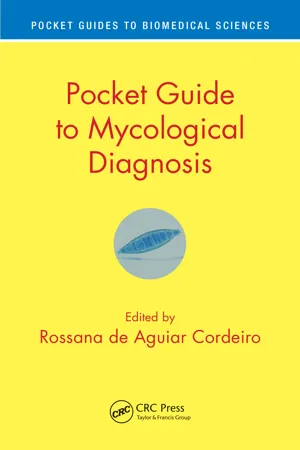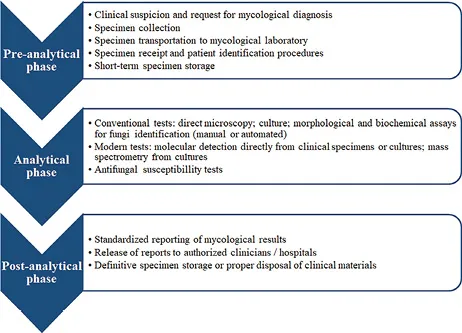
- 157 pages
- English
- ePUB (mobile friendly)
- Available on iOS & Android
Pocket Guide to Mycological Diagnosis
About this book
The Pocket Guide to Mycological Diagnosis provides useful and concise information for microbiologists and professionals diagnosing the most medically relevant fungal species. Cellular and molecular techniques, immunological methods, and more accurate microscopy equipment available in most mycology laboratories now make diagnosis more routine. Furthermore, information regarding medical mycology, including identification of specific fungal pathogens, is widely available. This book helps mycologists address the emerging challenges of diagnosis.
Key Features
-
- Succinct summary of fungal disease diagnosis
-
- Includes opportunistic fungal infections that can afflict immunocompromised patients
-
- Permits the identification of common fungal pathogens
-
- Reviews antifungal drugs
Related Titles
Ghannoum, M. A. & John R. Perfect, eds. Antifungal Therapy, 2nd ed. (ISBN 978-1-4987-6814-6)
Miyaji, M., ed. Animal Models in Medical Mycology (ISBN 978-1-3158-9059-3)
Razzaghi-Abyaneh, M., M. Shams-Ghahfarokhi and M. Rai, eds. Medical Mycology: Current Trends and Future Prospects (ISBN 978-1-4987-1421-1)
Frequently asked questions
- Essential is ideal for learners and professionals who enjoy exploring a wide range of subjects. Access the Essential Library with 800,000+ trusted titles and best-sellers across business, personal growth, and the humanities. Includes unlimited reading time and Standard Read Aloud voice.
- Complete: Perfect for advanced learners and researchers needing full, unrestricted access. Unlock 1.4M+ books across hundreds of subjects, including academic and specialized titles. The Complete Plan also includes advanced features like Premium Read Aloud and Research Assistant.
Please note we cannot support devices running on iOS 13 and Android 7 or earlier. Learn more about using the app.
Information
| Table 1.1 Minimum Biosafety Items Required for Clinical Mycological Laboratories | |||
| Primary Barriers | Secondary Barriers | ||
| Individual Protection Equipment | Structural Issues | Inside the Lab | Outside the Lab |
| Long-sleeved laboratory coats Gowns Gloves Masks and respiratory apparatus Eye protection/safety goggles Facial protection (face shields/splatter guard) Shoe covers | Restricted containment areas Class II biological safety cabinet Incinerators Bioaerosol-contention equipment Containers for disposal of sharp materials Mechanical pipetting device Washable floor Sturdy furniture | Sinks for hand washing Bench tops impervious to water and chemicals Autoclave Sealed windows or windows fitted with screens | Self-closing and lockable doors Eyewash station Safety shower Fire extinguisher/blanket |

Table of contents
- Cover
- Half Title
- Series Page
- Title Page
- Copyright Page
- Contents
- Preface
- Editor
- Contributors
- List of Abbreviations
- 1. Mycological Diagnosis: General Principles
- 2. Antifungal Drugs and Susceptibility Testing of Fungi
- 3. Candida spp.
- 4. Cryptococcus
- 5. Trichosporon
- 6. Malassezia
- 7. Rhodotorula spp.
- 8. Dermatophytes
- 9. Aspergillus spp.
- 10. Mucorales
- 11. Sporothrix spp.
- 12. Histoplasma capsulatum
- 13. Paracoccidioides Complex
- 14. Coccidioides
- 15. Pneumocystis jirovecii
- Index